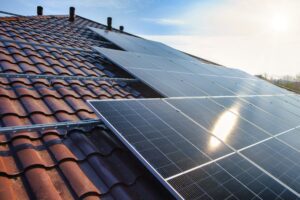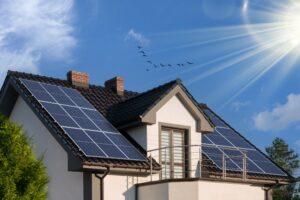Going solar saves money and reduces carbon emissions. But maximising these benefits can be challenging. Solar panels only produce electricity during the hours of daylight, when homes typically need less power. So a lot of your solar energy can go to waste.
Traditionally, the solution comes in the form of battery storage. Solar batteries store surplus energy accumulated during the day so you can use it later, when power demand peaks. However, solar batteries are expensive and may cost as much as your solar panels. If your budget doesn’t stretch to solar battery storage, a more affordable alternative is a solar power diverter.
This guide takes an in-depth look at solar diverters, including costs and their advantages and drawbacks. This will help you decide whether a solar diverter could be a good choice for your home.
What Is A Solar Diverter?
Also known as a photovoltaic (PV) immersion controller, a solar power diverter is a small, smart electronic device that increases use of energy generated by solar panels. It identifies in real time how much solar power is being produced and how much your household is consuming.
Solar diverters are typically connected to an immersion heater or electric heating system. When solar energy production exceeds consumption, the surplus power is routed through the water heating system.
The diverter monitors power production with two current transformers, one attached to the solar power inverter in the system and another fitted to the electricity meter. It then diverts excess electricity to power hot water and electric heating systems instead of sending it to the National Grid.
Powering an immersion heater or a boiler in this way saves free energy from going to waste. It improves household energy efficiency and reduces reliance on mains electricity for water heating and space heating.
Solar diverters can also be used to:
- Route energy to a solar battery.
- Supply power to charge an electric vehicle.
- Divert energy to devices plugged into electrical sockets.
How Does A Solar Diverter Work?
Most solar diverters are designed to work with solar power systems connected to the public electricity grid. They have four basic functions:
- Monitoring solar energy production and consumption. The diverter continuously measures the amount of electricity generated by solar panels alongside how much power the household is using.
- Detecting excess energy. When the solar energy system is producing more electricity than is being used, the diverter identifies the surplus energy that can be diverted.
- Solar energy diversion. The diverter automatically redirects excess electricity for household use, such as running an immersion heater, instead of allowing it to go back to the utility grid.
- Real-time adjustments. The solar diverter regulates the amount of energy diverted in real time, based on ongoing power generation and consumption. This ensures no energy is wasted.
A critical part of solar diverter operation is synchronisation with the National Grid to ensure safety and efficiency. Diverters integrate seamlessly with the grid supply, which makes sure the power supply is stable and reliable.
Off-Grid Diverters
Off-grid diverters operate in systems not connected to the electricity grid and generally involve battery storage. The diverter optimises solar energy use by prioritising direct consumption and battery charging before diverting energy for other purposes.
Solar Diverter Installation
Installing a solar diverter is a relatively quick and simple job for a professional because it mainly involves integration with an existing solar panel setup and electrical system.
To ensure compliance with safety regulations, solar diverters need to be installed by a professional solar panel company or a qualified electrician.
Wireless Solar Diverters
Instead of cables, a wireless solar diverter uses Wi-Fi signals or radio frequency to connect the components between the immersion heater, electrical supply, and solar system. Wireless solar diverters are easier to install and offer more flexibility in placement. But issues may arise with interference.
Solar Diverter Costs And Savings
The cost of a solar diverter, including supply and installation, typically ranges from £300 to £500 – considerably less than a solar battery.
The actual price you’ll pay depends on several factors including the brand, model, features, and installation requirements. Like solar panels and batteries, there’s currently no value added tax on solar diverters. The zero rate of VAT, which applies when a solar diverter is supplied and installed by the same company, will run until the end of March 2027. It’s then expected to revert to the original reduced rate of five percent.
How much money a solar diverter can save you depends largely on the power output of your solar panel system and how much electricity your house consumes during the day. Solar diverters can often pay for themselves in just two years.
Immersion heathers are expensive to run, costing several hundred pounds a year in some cases. A solar diverter can significantly reduce these costs, heating your water for free at certain times.
Solar Diverter Advantages
Advantages of a solar diverter include:
- Lower cost than a solar battery.
- Free hot water.
- More energy self-consumption.
- Savings on electricity bills.
Cheaper than installing solar battery storage, a solar diverter is a budget-friendly way to increase self-consumption of solar energy. It makes more use of the electricity your solar panels produce by enabling you to heat water (like a solar thermal panel system).
Redirecting surplus solar electricity to provide hot water and space heating further reduces energy bills and your carbon footprint. And it does this automatically – you don’t have to lift a finger.
It stores energy as heat in your hot water tank. This cuts energy bills as you heat your water supply with free electricity rather than using the utility grid to provide all your hot water. However, solar diverters do have their downsides.
Solar Diverter Disadvantages
Solar diverters have fairly limited applications, need optimal solar power generation, require specific installation conditions, and have a shorter lifespan than solar panels.
They work mainly with electric water-heating systems, so you need an immersion heater, combi boiler, or a heat pump, with a hot water storage cylinder. And a solar diverter is unlikely to be much use when solar panel output declines, during the shorter days of winter or in overcast weather, for example.
A further potential drawback is that your water heater may need to be fairly near the electrical setup, which might not be practical in some homes.
While solar panels generally last 25 to 30 years, a solar diverter has a lifespan of around 12 years, depending on the quality of the diverter, usage patterns, and upkeep. This means you’ll need to replace your diverter at some point.
Although a solar diverter is cost effective, the disadvantages mean they can’t offer the same level of financial benefits as a solar battery.
Solar Diverter Vs Solar Battery
Solar diverters and solar batteries both allow you to optimise the energy your solar panels produce. This gives you greater energy independence, which reduces electricity bills more than solar panels on their own.
Diverters are cost effective but don’t offer the same level of financial savings and energy independence as solar battery storage.
A solar battery offers far more flexibility in how surplus solar electricity is used. It stores energy for use at any time, day or night, to power household lighting and a wide range of electrical appliances and devices. A solar diverter, on the other hand, is typically limited to heating water.
However, solar batteries are much more expensive, ranging in price from around £3,500 for a small household, £10,000 for a medium-sized home, and £20,000 for larger properties. Solar diverters cost a few hundred pounds.
Both solar batteries and solar diverters need to be replaced periodically during the lifespan of a solar panel system. A battery, though, generally needs more maintenance.
Some solar diverters can be designed to work alongside solar batteries, with the diverter activating only when the battery is fully charged.
While it’s technically possible to use a solar diverter with a battery storage system, it’s generally not recommended. Batteries already do the job of storing excess solar power, so there’s no real need for a diverter as well.
Is A Solar Diverter Right For Your Home?
A solar diverter could be a good choice for your home if you’re looking to make more efficient use of your solar panels and don’t want to invest in solar battery storage. It provides an alternative to the more expensive solar battery and is the next-best option.
Diverting free electricity to your hot water system and powering the immersion heater in your hot water tank, for instance, reduces dependence on expensive mains electricity.
The UK has seen the introduction of the latest solar diverter models with state-of-the-art technologies. These systems offer advanced energy management features, improved compatibility with different appliances, and user-friendly monitoring and control systems.
That said, although solar diverters cost a lot less than a solar battery, they can’t optimise cost savings or reduce carbon footprint to the same level. Leading renewable energy specialists Effective Home can help you decide whether a solar diverter is right for your home and tell you how much it would cost. Contact us now.



